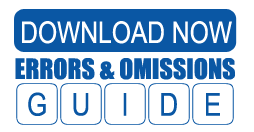McGowanPRO
What are insurance underwriters looking for in an investment advisor’s application for errors & omissions (aka professional liability) insurance?
Download the comprehensive 33-page Guide to gain:
– Clarity to the Insurance Evaluation Process
– Specific Guidance and Roadmap to Improved Outcomes
– Risk Management Resources for your Practice
Regulatory & SEC Audits
Part 2: The Investment Advisors Guide to Errors & Omissons Insurance
 By Gary Sutherland, CIC, MLIS
By Gary Sutherland, CIC, MLIS
If your firm has undergone a Regulatory or SEC audit, it will be disclosed on your application and further evaluation will be take place. In most cases, a series of questions relevant to the audit will be asked. The purpose of the examination is to determine if any specific disclosures require further review and to confirm if the regulatory recommendations have been addressed.
These questions are intended to go deeper than the standard application. They will expand the review to include anyone who provides professional services at the applicant firm, and will explore their relevant past history, in addition to the firm’s history. Underwriters consider it a red flag when an undisclosed issue related to an individual, or the firm, is uncovered that should have been disclosed on the application. It is always better to fully disclose these types of issues up front in the submission process, and avoid creating concern with the underwriter that other items may not have been disclosed as well. In addition, by not disclosing upfront, you miss the opportunity to proactively make a positive case in the initial review process.
When it comes to SEC audits, underwriters are not overly concerned with housekeeping type issues, unless they are pervasive in nature. An experienced insurance agent can position the SEC audit positively to an underwriter by tracking the process, and emphasizing the fact that a third-party has reviewed the firm. Once your firm has complied with any required corrections, the argument should be made that the firm is now a better risk than one that has not gone through a similar audit process.
However, SEC audits can also indicate a trail of bad record-keeping, conflicts of interest, lack of fee transparency, and written disclosures. This is where an extremely good narrative is required, one that provides a proactive bullet point response to the underwriter, outlines what corrections have been made and how the applicant firm has changed its prevailing culture.
Citing outside compliance assistance and expert guidance can clearly help elevate a negative portrayal of the firm. Applicant firms should be specific in naming the outside vendors. If compliance or ERISA attorneys were retained, adding these external experts’ bios with the application is beneficial.
Conclusion
Audits are a natural part of the investment industry. An audit in itself should not be considered a negative against your firm in the errors & omissions insurance process. Keep in mind when responding to an audit and the corrective measures that result, your responses and overall approach will be public. An underwriter will see this information, and clarity and professionalism can make this record a positive.
Our suggestions:
1. Provide a detailed narrative regarding your audit experience. At this point you should see a theme developing about the use of narratives to proactively influence the underwriting process.
2. Even in negative situations, emphasize the positive steps that have been taken to address the original issue.
3. Include specifics regarding expert guidance utilized in the process.
Back to Series Main Page
Contact us for additional information:
Gary Sutherland, MLIS, CIC Garys@mcgowanprofessional.com 508-656-1350

